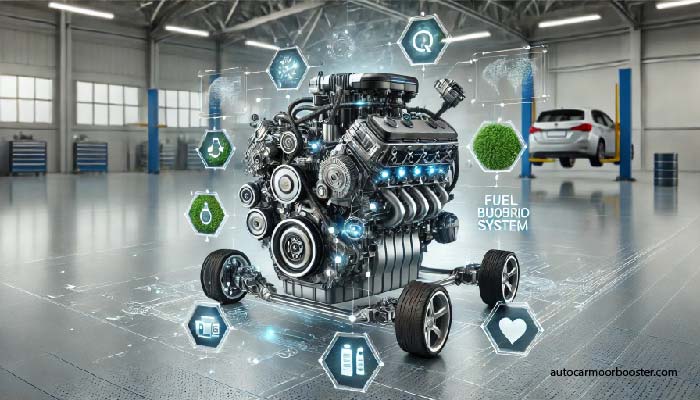Hybrid boosting systems are transforming the automotive and industrial sectors by enhancing performance and efficiency. These systems combine traditional fuel engines with electric power sources, creating a hybrid system that optimizes energy usage, improves speed, and reduces emissions. This article explains hybrid boosting systems, their types, and how they contribute to enhanced performance in vehicles and machinery.
Understanding Hybrid Boosting Systems
A hybrid boosting system utilizes multiple power sources, such as an internal combustion engine (ICE) paired with electric motors. This combination enables the vehicle or machine to switch between power sources based on performance needs. For example, an electric motor provides boosting power for acceleration, while the ICE takes over for sustained driving. These systems aim to maximize fuel efficiency and lower carbon emissions, catering to the increasing demand for sustainable performance solutions.
Key Benefits of Hybrid Boosting Systems
- Increased Efficiency
Hybrid systems significantly improve fuel efficiency by optimizing the power source. Electric motors handle low-speed tasks, while fuel engines kick in for high-performance needs, reducing the load on each component. - Lower Emissions
Using electric motors in hybrid systems helps reduce carbon emissions. This makes hybrid technology a valuable asset in addressing environmental concerns in transportation and industrial applications. - Enhanced Power Output
The combination of electric and combustion engines delivers higher power output for vehicles and machines. This boosting performance is essential in applications where both speed and efficiency are required. - Reduced Fuel Consumption
Hybrid systems consume less fuel by using electricity as an alternative energy source. This contributes to cost savings and aligns with the global shift toward eco-friendly energy sources.
Types of Hybrid Boosting Systems
- Mild Hybrid
A mild hybrid system uses a small electric motor that assists the main engine. It cannot operate independently but supports the engine during acceleration and stop-start functions. Mild hybrids are cost-effective and commonly used in standard vehicles. - Full Hybrid
Full hybrids, or HEVs, can operate on either the electric motor or the fuel engine alone. These systems are more flexible and allow electric-only driving in low-speed conditions, contributing to significant fuel savings. - Plug-in Hybrid (PHEV)
PHEVs have larger batteries and can be recharged by plugging into an external source. They offer extended electric-only driving ranges and can switch to the fuel engine for longer journeys. - Series Hybrid
In a series hybrid system, the electric motor powers the wheels, while the fuel engine generates electricity for the motor. This type provides consistent power output and is ideal for high-performance tasks. - Parallel Hybrid
In parallel hybrids, both the electric motor and fuel engine are connected to the wheels. They work simultaneously to deliver power, improving acceleration and fuel economy.
Real-World Applications of Hybrid Boosting Systems
Hybrid systems are widely used in vehicles, especially electric and hybrid cars. These vehicles can operate on electric power in cities, switching to fuel engines on highways. Additionally, hybrid boosting technology is gaining popularity in industrial machinery, offering enhanced performance for heavy-duty tasks while minimizing fuel consumption and emissions.
Challenges in Implementing Hybrid Systems
Despite their advantages, hybrid systems face challenges such as high manufacturing costs, battery efficiency limitations, and the need for a comprehensive charging infrastructure. However, advancements in battery technology and government incentives are gradually addressing these issues, making hybrid technology more accessible.
Future of Hybrid Boosting Systems
With the push towards sustainable energy solutions, hybrid systems are expected to play a crucial role in future transportation and industrial applications. Innovations in battery technology, energy management, and electric motor efficiency will likely drive further performance enhancements.
Conclusion
Hybrid boosting systems offer a powerful solution for enhancing performance and efficiency. By combining the strengths of electric and fuel engines, these systems provide eco-friendly performance that meets today’s energy and environmental demands. As hybrid technology advances, it will continue to redefine performance standards in vehicles and machinery.
FAQs about Hybrid Boosting Systems
1. What is a hybrid boosting system?
A hybrid boosting system combines electric and fuel engines to enhance performance and efficiency. It optimizes energy usage and reduces emissions by switching between power sources as needed.
2. How does a hybrid boosting system improve fuel efficiency?
Hybrid systems improve fuel efficiency by using electric motors for low-speed tasks, reducing the load on fuel engines. This saves fuel and lowers overall consumption.
3. What are the different types of hybrid systems?
There are five main types: mild hybrid, full hybrid, plug-in hybrid, series hybrid, and parallel hybrid. Each type has unique features and benefits for specific applications.
4. Why are hybrid systems considered eco-friendly?
Hybrid systems reduce carbon emissions by utilizing electric power, which results in fewer pollutants and a lower environmental impact compared to traditional fuel engines.
5. What are the challenges of hybrid boosting systems?
Challenges include high production costs, limited battery life, and the need for charging infrastructure. However, ongoing advancements are helping to overcome these barriers.
If Like This Article Visit Our Website. Collect From Wekiapedia
